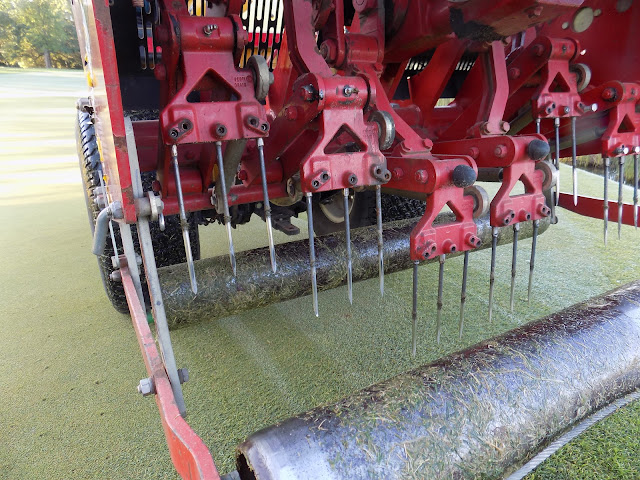Congratulations to all of us new step-grandparents. as our adopted pair of Mute Swans have hatched their first flock of cygnets. The linked article, Baby Swans: All You Need To Know is a very informative article. If you're interested you should checkout and prepare for what comes next with our new arrivals. We will of course document what we can.
In other golf course news, we deep tined and sand top-dressed greens this past Monday 5/25/23. Pictures below are worth a thousand words.
 |
The first sighting of the hatched Cygnets was Friday 5/27/23 by Ken Roberts captured here. |
 |
I immediately put the flying camera up to confirm our numbers and am happy to report we currently have six healthy Cygnets. |
 |
Here they are a day (?) old on Saturday 5/26/23 frolicking and feeding with their parents. Photo captured by GCM employe partner Amanda Bergstrom. |
 |
This photo was taken Monday 5/22/23 before we became aware of the new arrivals. Geese were nearby on #9 fairway and possibly chased out of the pond by protective parent. |
Other GBGC Wildlife News
 |
I suspect the pair above or at least the brown wren were the parents of the eggs in birdbox behind #11 tee that I highlighted last week. This was taken right above the location of the bird box. |
 |
Unfortunately, when I checked the birdbox on Friday it was empty with no remnants of shells or anything in or below the nest. I thought parents might have moved the eggs because of my poking around and then found out that wrens will move eggs for various reasons. Check out the below link. Wrens Can Be Nasty Neighbors |
Deep Tine Aeration
 |
Enrique deep tineing or aerating the greens on Monday 5/25/23. |
 |
As you can see here this practice will not affect putting quality. |
 |
In addition to, and even more importantly, if we are going to avoid aggressive core aeration in the future with these new green's, we will need to frequently apply light dustings of sand to dilute the organic matter that a bent grass putting surface produce's naturally. The targeted amount of sand prescribed by the USGA Annual Sand Topdressing Amounts is anywhere between 25 and 30 cubic feet of sand per 1000 square feet per year. We are targeting 30. The above and below pictured application represents approximately 1 cubic foot per 1000 square feet. It is difficult to achieve 30 cubic feet per year just with light topdressings like this. It is easier to achieve if you aggressively aerate twice per year, but we are trying to avoid that if possible. We will need to get a little more aggressive with aeration such as a closer pattern of holes of either solid or coring to A - mechanically remove organic matter and B - allow for more topdressing sand incorporation helping reach the target of 30 cubic feet of sand per year. |

















